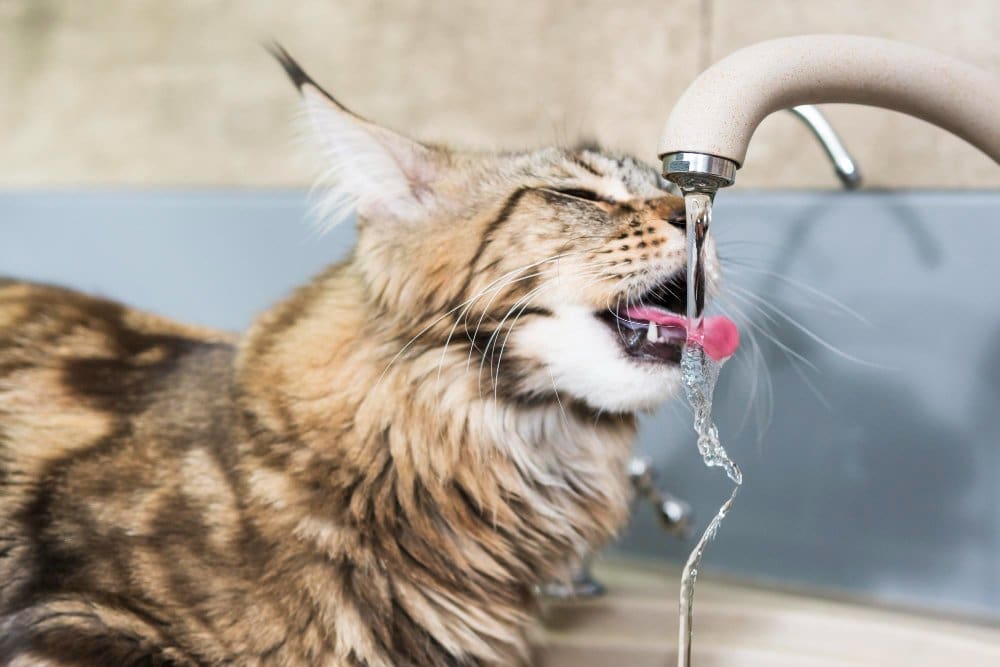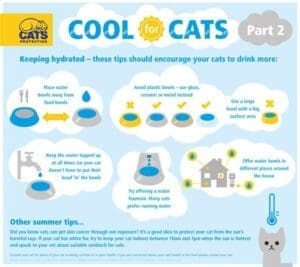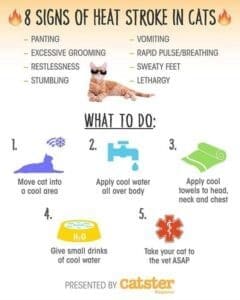As the weather heats up, it’s important to remember that your furry friend, your cat, is also susceptible to the dangers of hot weather. In this article, you will discover simple yet crucial tips to protect your cat from heatstroke and other hazards that come with soaring temperatures. Whether it’s providing a cool shade, ensuring ample hydration, or recognizing the signs of heat-related distress, by implementing these measures, you can keep your feline companion safe and comfortable during the scorching summer months.
Signs and Symptoms of Heatstroke
Heatstroke is a serious and potentially life-threatening condition that can affect cats when they become overheated. It’s important for cat owners to be aware of the signs and symptoms of heatstroke so they can take immediate action if their pet is in distress. Some common signs of heatstroke in cats include excessive panting and drooling, rapid breathing, increased heart rate, weakness and lethargy, vomiting and diarrhea, and ultimately, collapse and loss of consciousness. If you notice any of these symptoms, it’s crucial to act quickly and seek veterinary care immediately.
Preventing Heatstroke
Prevention is always better than cure when it comes to heatstroke. Here are some measures you can take to keep your cat cool and minimize the risk of heatstroke during hot weather.
Keep your cat indoors during the hottest hours of the day
The hottest hours of the day are typically between 10 am and 4 pm. By keeping your cat indoors during this time, you can help them avoid excessive heat exposure.
Provide access to cool and shaded areas
Create cool and shaded areas in your home where your cat can seek refuge from the heat. This can be achieved by closing curtains, using shades, or setting up cozy spots in cool corners of the house.
Ensure an adequate supply of fresh water
Make sure your cat always has access to fresh and cool water. Replace the water regularly throughout the day to keep it fresh and enticing for your feline friend.
Use fans or air conditioning to keep the environment cool
Fans or air conditioning can help circulate cool air and lower the overall temperature in your home. Consider setting up fans in rooms where your cat spends most of their time or invest in an air conditioning system to maintain a comfortable environment for your pet.
Avoid strenuous activities during hot weather
Engaging in high-energy activities during hot weather can put your cat at risk of heatstroke. Instead, opt for mellow indoor play sessions during the hottest times of the day to keep your cat entertained without risking overheating.
Safe Outdoor Activities
While it’s generally safer to keep your cat indoors during hot weather, some cats enjoy spending time outdoors. If you choose to allow your cat outside during the warmer months, here are some tips to ensure their safety.
Supervise outdoor time
Always supervise your cat when they are outside, especially during hot weather. This allows you to closely monitor their behavior and bring them indoors if signs of heatstroke or discomfort arise.
Use a cat-friendly sunscreen
Just like humans, cats can get sunburned. Apply a cat-friendly sunscreen to areas that are exposed to the sun, such as the ears, nose, and the outside of their body, to protect their delicate skin from harmful UV rays.
Avoid walking on hot surfaces
Hot surfaces like asphalt or concrete can quickly heat up and burn your cat’s paws. Before taking your cat for a walk, check the temperature of the surface by placing the back of your hand on it. If it’s too hot for you, it’s too hot for your cat.
Provide a shallow water source
A shallow water source, such as a small pond or a pet-friendly pool, can help your cat cool off if they choose to. Make sure the water is clean and easily accessible for your cat to safely enjoy.
Consider creating a catio
A catio, or an enclosed outdoor space for cats, provides a secure and shaded environment for your cat to enjoy outdoor time without exposure to excessive heat. Consider building or purchasing a catio to give your cat the best of both worlds – outdoor enjoyment without the risks.
Protecting Paws from Hot Surfaces
Walking on hot surfaces can lead to painful burns on your cat’s sensitive paws. Here’s how you can protect their paws from the heat.
Check pavement and sand temperatures
Before taking your cat for a walk, ensure that the pavement or sand is not too hot. Place the back of your hand on the surface for a few seconds to test its temperature. If it feels uncomfortably hot to your hand, it’s best to avoid walking on it.
Use paw protection products
Paw protection products, such as booties or paw wax, can provide a barrier between your cat’s paws and hot surfaces. These products can help prevent burns and discomfort while your cat explores their surroundings.
Consider booties or paw wax
Booties are small shoes designed to protect your cat’s paws from hot surfaces. They are made of breathable materials and are available in various sizes to fit your cat comfortably. Alternatively, paw wax can be applied to create a protective layer on their paws.
Avoiding Sunburn
Just like humans, cats can also suffer from sunburn. Here’s how you can protect your cat’s sensitive skin from harmful UV rays.
Limit sun exposure during the peak hours
Try to limit your cat’s exposure to direct sunlight during the peak hours of the day, typically between 10 am and 4 pm. These are the times when the sun’s rays are strongest and can cause the most damage.
Provide shade and cover
Create shaded areas in your home, both indoors and outdoors, where your cat can retreat from the sun. This can be achieved by using umbrellas, screens, or setting up cat-friendly structures that provide cover.
Use pet-safe sunscreen
If your cat has areas of exposed skin, such as ears or noses, you can apply pet-safe sunscreen to protect them from harmful UV rays. Make sure to choose a sunscreen specifically formulated for cats, as some products designed for human use can be toxic to pets.
Protect light-colored or hairless areas
Cats with light-colored fur or hairless breeds are more susceptible to sunburn. Take extra caution to protect these areas by keeping them covered or applying pet-safe sunscreen.
Preventing Dehydration
Dehydration is a common issue during hot weather and can exacerbate the risk of heatstroke in cats. Here’s how you can ensure your cat stays hydrated.
Make sure your cat drinks enough water
Encourage your cat to drink by providing fresh and clean water at all times. Cats can be fussy about their water source, so consider offering different types of water, such as filtered or bottled water, to entice them to drink more.
Offer wet food or add water to dry food
Wet food contains a higher water content compared to dry kibble. Incorporating wet food into your cat’s diet during hot weather helps increase their overall water intake. If your cat prefers dry food, you can add water to their kibble to make it more hydrating.
Use a pet fountain or dripping faucet
Some cats prefer drinking from running water sources. Consider investing in a pet fountain or turning on a dripping faucet to provide a constant flow of fresh water that may attract your cat and encourage them to drink more.
Monitor water intake
Keep an eye on your cat’s water intake. If you notice a significant decrease in their water consumption or signs of dehydration, such as dry gums or sunken eyes, contact your veterinarian for further guidance.
Recognizing and Treating Dehydration
Dehydration can quickly become a serious concern, especially during hot weather. Here’s how to recognize and address dehydration in cats.
Signs of dehydration
Common signs of dehydration in cats include dry and sticky gums, sunken eyes, loss of appetite, lethargy, decreased urination, and skin that is slow to return to its normal position when gently pulled. If you notice any of these signs, it’s important to act promptly.
Providing fluids to your cat
If you suspect your cat is dehydrated, offer small amounts of water every hour to encourage drinking. You can also provide them with a veterinarian-approved electrolyte solution to replenish essential fluids and minerals.
Contacting a veterinarian
If your cat’s condition does not improve or if they show severe signs of dehydration, it is crucial to seek veterinary care immediately. Your veterinarian can assess the situation, provide appropriate treatment, and advise you on how to prevent future episodes of dehydration.
Summer Grooming
Grooming plays an important role in keeping your cat comfortable during hot weather. Here are some grooming tips to help your cat stay cool and comfortable in the summer.
Brushing your cat’s fur
Regular brushing helps remove excess fur and prevents matting, which can trap heat against the skin. Brush your cat’s fur frequently, especially if they have long or thick hair, to promote better air circulation and reduce the risk of overheating.
Avoiding excessive trimming
While it may be tempting to give your cat a close shave during hot weather, be cautious with excessive trimming. Cats’ fur acts as insulation, protecting them from both heat and cold. Instead of shaving their entire coat, focus on trimming longer areas and removing any mats or tangles.
Consider a professional grooming
If your cat’s fur becomes excessively matted or they struggle with grooming, consider seeking the help of a professional groomer. They can trim or shape your cat’s fur while keeping their overall coat intact to provide necessary insulation.
Bathing your cat
Some cats enjoy water and can benefit from a cool bath during hot weather. However, not all cats tolerate bathing, so it’s important to assess your cat’s personality and comfort level before attempting a bath. Use lukewarm water and a cat-friendly shampoo to keep them clean and refreshed.
Regular flea and tick prevention
During the summer months, fleas and ticks are more active. Regularly apply flea and tick prevention products recommended by your veterinarian to protect your cat from infestations and the associated discomfort or diseases.
Foods to Avoid
Certain foods can be harmful or even toxic to cats, especially during hot weather when their bodies may be more susceptible. Avoid feeding them the following foods to protect their health.
Heat-sensitive food items
Be cautious when leaving out heat-sensitive food items, such as dairy products or cooked meats. These foods can spoil quickly in warm temperatures and may cause food poisoning or stomach upset when consumed by cats.
Toxic foods for cats
Some human foods are toxic to cats and should never be fed to them. These include chocolate, onions, garlic, grapes and raisins, alcohol, caffeine, and certain artificial sweeteners. Ensure that your cats cannot access these foods to keep them safe and healthy.
Emergency Preparedness
It’s essential to be prepared for potential emergencies, especially during hot weather when the risk of heatstroke increases. Here are some steps you can take to be ready for unexpected situations.
Knowing the signs of heatstroke emergency
Being aware of the signs of a heatstroke emergency can help you take immediate action. If your cat displays symptoms such as collapse, loss of consciousness, seizures, or extreme distress, it may indicate a severe heatstroke emergency. Contact your veterinarian or an emergency veterinary clinic right away for guidance.
Seeking immediate veterinary care
If you suspect that your cat is suffering from heatstroke, it’s crucial to seek immediate veterinary care. Heatstroke can quickly turn life-threatening, and only a veterinarian can provide the proper medical treatment necessary to save your cat’s life.
Pet emergency kit
Putting together a pet emergency kit is a proactive step in ensuring your cat’s safety during emergencies. Include items such as a pet thermometer, your veterinarian’s contact information, emergency veterinary clinic numbers, and any necessary medications your cat may need. Keep this kit easily accessible in case of an emergency.
In conclusion, keeping your cat safe during hot weather requires careful attention and proactive measures. By being aware of the signs and symptoms of heatstroke, ensuring your cat has access to cool and shaded areas, protecting their paws and skin, promoting hydration, and taking appropriate grooming and dietary precautions, you can help your cat stay comfortable and healthy even during the hottest days of summer. Remember, prevention is key, and being prepared for emergencies can make all the difference in protecting your furry friend. Stay vigilant, stay cool, and enjoy a safe summer with your beloved cat!



